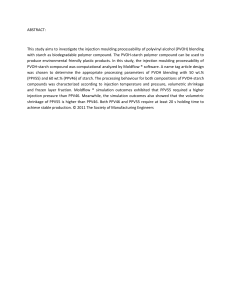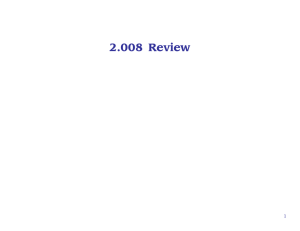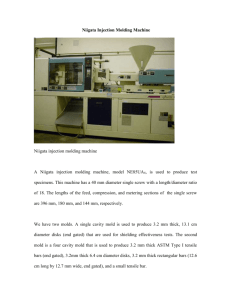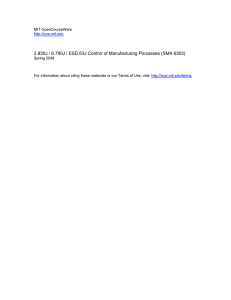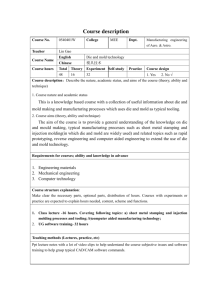A Study on Computer Simulation of Plastic Lens Molding Process W
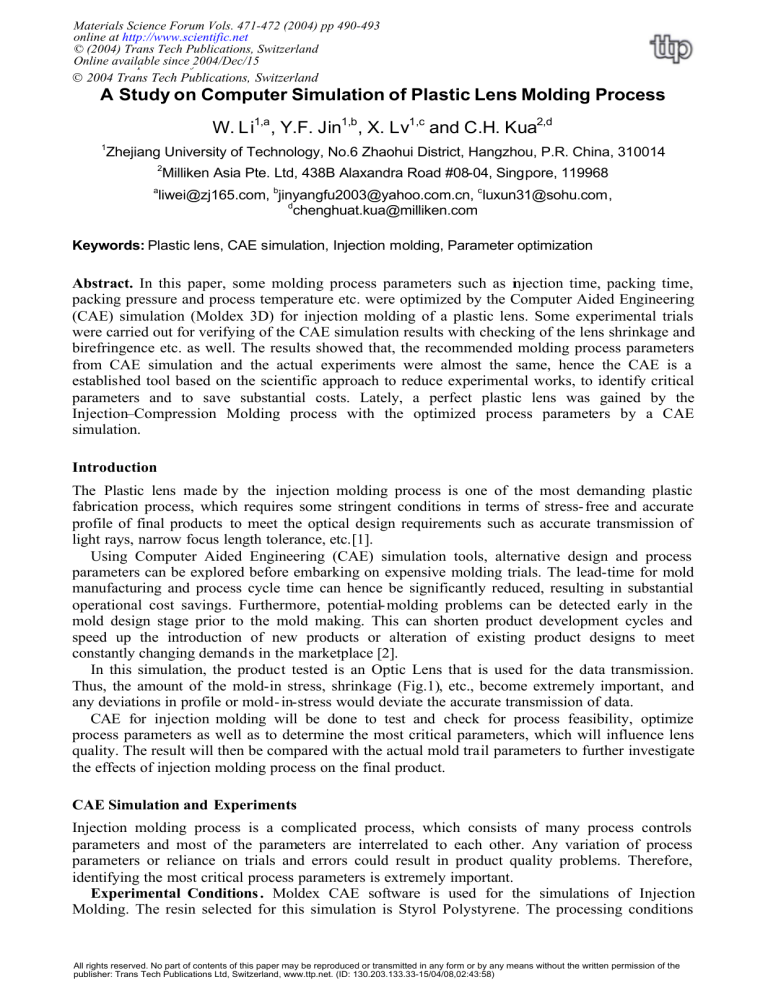
Materials Science Forum Vols. 471-472 (2004) pp 490-493 online at http://www.scientific.net
© (2004) Trans Tech Publications, Switzerland
Online available since 2004/Dec/15
2004 Trans Tech Publications, Switzerland
A Study on Computer Simulation of Plastic Lens Molding Process
W. Li
1,a
, Y.F. Jin
1,b
, X. Lv
1,c
and C.H. Kua
2,d
1
Zhejiang University of Technology, No.6 Zhaohui District, Hangzhou, P.R. China, 310014
2
Milliken Asia Pte. Ltd, 438B Alaxandra Road #08-04, Singpore, 119968 a liwei@zj165.com, b jinyangfu2003@yahoo.com.cn, c d chenghuat.kua@milliken.com luxun31@sohu.com,
Keywords: Plastic lens, CAE simulation, Injection molding, Parameter optimization
Abstract.
In this paper, some molding process parameters such as injection time, packing time, packing pressure and process temperature etc. were optimized by the Computer Aided Engineering
(CAE) simulation (Moldex 3D) for injection molding of a plastic lens. Some experimental trials were carried out for verifying of the CAE simulation results with checking of the lens shrinkage and birefringence etc. as well. The results showed that, the recommended molding process parameters from CAE simulation and the actual experiments were almost the same, hence the CAE is a established tool based on the scientific approach to reduce experimental works, to identify critical parameters and to save substantial costs. Lately, a perfect plastic lens was gained by the
Injection–Compression Molding process with the optimized process parameters by a CAE simulation.
Introduction
The Plastic lens made by the injection molding process is one of the most demanding plastic fabrication process, which requires some stringent conditions in terms of stress- free and accurate profile of final products to meet the optical design requirements such as accurate transmission of light rays, narrow focus length tolerance, etc.[1].
Using Computer Aided Engineering (CAE) simulation tools, alternative design and process parameters can be explored before embarking on expensive molding trials. The lead-time for mold manufacturing and process cycle time can hence be significantly reduced, resulting in substantial operational cost savings. Furthermore, potential- molding problems can be detected early in the mold design stage prior to the mold making. This can shorten product development cycles and speed up the introduction of new products or alteration of existing product designs to meet constantly changing demands in the marketplace [2].
In this simulation, the product tested is an Optic Lens that is used for the data transmission.
Thus, the amount of the mold-in stress, shrinkage (Fig.1), etc., become extremely important, and any deviations in profile or mold- in-stress would deviate the accurate transmission of data.
CAE for injection molding will be done to test and check for process feasibility, optimize process parameters as well as to determine the most critical parameters, which will influence lens quality. The result will then be compared with the actual mold trail parameters to further investigate the effects of injection molding process on the final product.
CAE Simulation and Experiments
Injection molding process is a complicated process, which consists of many process controls parameters and most of the parameters are interrelated to each other. Any variation of process parameters or reliance on trials and errors could result in product quality problems. Therefore, identifying the most critical process parameters is extremely important.
Experimental Conditions . Moldex CAE software is used for the simulations of Injection
Molding. The resin selected for this simulation is Styrol Polystyrene. The processing conditions
All rights reserved. No part of contents of this paper may be reproduced or transmitted in any form or by any means without the written permission of the publisher: Trans Tech Publications Ltd, Switzerland, www.ttp.net. (ID: 130.203.133.33-15/04/08,02:43:58)
Materials Science Forum Vols. 471-472
Materials Science Forum Vols. ***
491
491 recommended by the resin manufacturer and the default parameters setting from Moldex CAE are tabulated in Table1. The experiments were done in a Sodick injection molding machine TR 40/55
EH.
Table 1 Initial CAE simulation parameter
Melt temperature [ o
C ]
Mold temperature [ o
C ]
Injection pressure [Mpa]
230
50
120
Filling time [Sec ]
Packing pressure [ Mpa]
Packing time [Sec ]
Cooling time [ Sec ]
1
120
1
30
Optimization of the Critical Molding Process Parameters
Injection Time vs Injection Pressure . Injection time denotes the velocity at which the screw advances during the injection phase. The experiment showed that short injection time requires high pressure due to the high flow rate.
This item defines the time needed for the melt to fill the cavity during the filling stage.
Fig.2 shows that the lowest point is at 0.6 second. Hence, the optimum injection time is 0.6 second since that required lowest injection pressure.
Volumetric Shrinkage vs Packing Time. A packing pressure is exerted on the part according to the specified packing pressure profile over this time interval. If the specified fill time is too short, part of the pack time is used to push the melt until it fills the entire cavity.
50
CAE
Experiment
40
30
20
Fig.1 Volumetric shrinkage
10
0.0
0.2
0.4
0.6
0.8
Injection Time (second)
1.0
Fig.2 Injection time vs. injection pressure
Fig.3 showed that the pack time has the excellent effect in determining volume shrinkage.
In this experiment, the pack time of 2.5 second is selected because of the relatively low volumetric shrinkage of near to zero percent.
Volumetric Shrinkage vs Packing Pressure. Fig.4 shows that pack pressure has the excellent effect in determining volume shrinkage. Too high pack pressure and Too low pack pressure imposes may cause flashes formation or high shrinkage and heavy sink mark on the molded part.
It also shows that pack pressure of 50 Mpa is an ideal setting, because its results in the low volumetric shrinkage of near to zero percent.
Melt Temperature . Fig.5 shows that the melt temperature has a good effect in determining filling stress and volumetric shrinkage. However, the melt temperature must not be higher than a critical point such that high shrinkage and plastic degradation occur.
It also shows that the melt temperature of 230
°
C is an ideal setting, because this resulted in relatively and low volumetric shrinkage.
492
492
Advances in Materials Manufacturing Science and Technology
Advances in Materials Manufacturing Science and Technology
Mold Temperature . The main reasons for developing the optimal mold temperature are to improve the lens optical properties (lower birefringence) and to obtain better lens spherical contour which affect the focus length.
Higher mold temperature corresponds to a rise in the volumetric shrinkage.
Fig.6 shows that the mold temperature has a good effect in determining volume shrinkage, and the mold temperature of 50
°
C is an ideal setting, which is due to low volumetric shrinkage of near to zero.
2
4
3
2
1
0
CAE
Experiment
3
-1
1.0
1.5
2.0
2 . 5
Packing Time (sec)
3.0
Fig.3 Packing time vs. volumetric shrinkage
3.5
CAE
Experiment
1
0
-1
210 220 230 240 250 melt Temperature (
0
C)
Fig.5 melt Temperature vs volumetric shrinkage
Fig.5 Melt temperature vs. volumetric shrinkage
3
2
1
CAE
Experiment
0
2
3
-1
25 30 35 40 45 50 55 60
Packing Pressure (Mpa)
65 70 75
Fig.4 Packing pressure vs. volumetric shrinkage
CAE
Experiment
1
0
-1
2 0 30 40 50 60 mold Temperature (
0
C)
Fig.6 mold Temperature vs volumetric shrinkage
Fig.6 Mold temperature vs. volumetric shrinkage
70
Compare the Results with CAE
Table 2 shows the recommended parameter from the CAE simulation and the actual optimized parameter from the injection molding experiment. Hence, the results between the simulation and experimental trials are almost the same.
The differences are that the Injection pressure in CAE has a lower injection pressure and slightly shorter packing times than those the experiment. These differences could be due to the long nozzle of orifice diameter of 2.5 mm with the length of 100mm. This additional passage was not considered in the CAE simulation and it caused significant pressure drop due to such a narrow and long passage.
Materials Science Forum Vols. 471-472
Materials Science Forum Vols. ***
493
493
Experime nt Trials on Injection Compression Molding
The basic controlled parameters of Injection Compression Molding (ICM) are similar to the
Injection Molding (IM), with additional parameters to control the second motor to activate the compression motions.
It is obvious from Table 3 that the lenses produced by CIM had shrunk more and this will affect the contour (focus length) of the lenses. In comparison lenses produced by ICM have almost perfect lens thickness, hence, ICM is more suitable for production of high quality lenses.
Table 2 Compare molding parameters of the CAE with experimental optimized data
S/N
1
2
3
6
Parameter
Process temperature [
Mold temperature [
4 Filling time [ Sec]
°
°
C ]
C ]
Injection pressure [ Mpa ]
5 Packing pressure [ Mpa ]
Packing time [ Sec ]
CAE
Recommended data
230
50
20
0.6
50
2.5
Experimental Molding
Optimized data
230
50
36
0.6
50
3.0
Table 3 Compare the results of IM lenses with ICM lenses after optimization
Molding Method
Sample
No.1
IM
3.46
ICM
3.50
No.2 3.47 3.50
No.3
No.4
3.47
3.46
3.50
3.49
No.5 3.45 3.50
ICM Setting: Pre- fill = 97%, delay time = 0.5 second
Spherical Lens Thickness
(Volumetric Shrinkage)
Conclusions
According to the above mentioned CAE and experimental results, the following conclusions can be obtained:
1. Packing pressure, Packing time and Mold temperature have significant effect on lens focus length (Spherical surface shrinkage).
2. CAE is capable for predicting the generation of birefringence, and providing quantitative results. The volume shrinkage with the experimental molding parameters is similar to the simulated results.
3. Lenses produced by Injection Compression Molding (ICM) have almost perfect lens thickness, hence, Injection Compression Molding (ICM) is more suitable for the production of high quality lenses.
References
[1] C. Wu, Y.L. Su: Intern. Comm. in Heat and Mass Transfer Vol. 30 (2003), p. 215
[2] B.F. Fan, D. Kazmer, R. Theriault, et al: Polym. Engin. and Science Vol. 43 (2003), p. 596.
